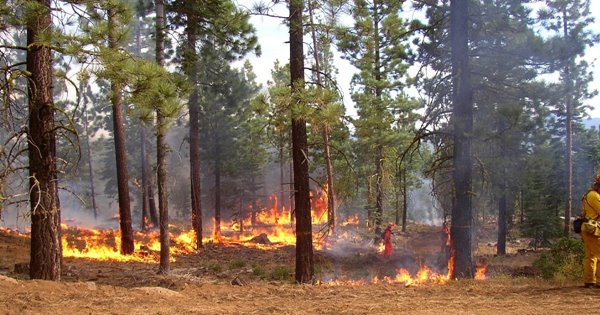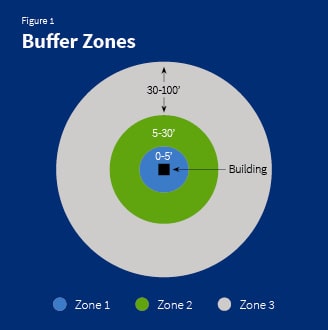Summary: Wildfires cause millions of dollars in damage to structures and burns through millions of acres each year. Learn how to protect and prepare your business and commercial property by having a wildfire preparation plan. Wildfire Risk Assessment for Businesses
Wildfires are one of nature’s most powerful and deadly forces. The
National Interagency Fire Center (NIFC) reports that so far in 2023, 21,305 wildfires have burned 644,918 acres in the United States. The
NIFC annual report found that there were 68,988 reported wildfires in 2022 damaging over seven million acres of land, up 17% from 2021 wildfire numbers.
For businesses located in an area prone to wildfires, the risks can be on the rise. So, it’s more important than ever to take measures to
reduce the risks posed by wildfires to your employees, customers, business property, equipment and other assets.

Almost nine times out of ten, humans are the cause of wildfires. These fires can be fast-moving and unpredictable. In addition to the
direct impact an out-of-control fire can have on your building and property, businesses can also suffer indirect consequences such as service disruption, transportation stoppage and utility interruption. That could mean a lengthy and costly recovery, possibly forcing you to pass the costs on to your customers in the form of higher prices.
It’s a good idea to know which
Fire Hazard Severity Zone (FHSZ) your business is located in. You can request the FHSZ rating of your area from your local building or fire officials (or if you are in California, see the
Cal Fire FHZ Viewer). FHSZ ratings represent the wildfire hazard in each area based on the local plants and landscaping, fire history, slope, and other terrain features that could impact a fire’s spread. These zones are generally classified as “moderate,” “high” or “very high/extreme.” Depending on a community’s construction ordinances, the FHSZ can be the basis for specific requirements regarding construction materials, landscaping, maintenance and other operational decisions.
Three Ways Wildfires Can Destroy Your Business's Property
When you think about your business’s possible damage from a wildfire, the most obvious damage is from direct flames. But your property doesn’t have to take a direct hit from the advancing flames to be damaged or destroyed during a
wildfire emergency. There are three ways a fire can impact your property:
- Direct Flames: This is the most obvious, with the advancing fire damaging or consuming your property, burning everything in its path.
- Airborne Embers: Burning embers generated by a wildfire become airborne and can be carried by winds, potentially falling on combustible materials and buildings, creating more fires. These embers can even travel long distances before landing on or near buildings. Burning embers can enter through open windows and unprotected vents, directly igniting combustible materials inside.
- Radiant Heat: If the radiant heat put off by a wildfire is high enough and the duration close to your building is long enough, it can ignite combustible material such as wood siding and even break glass in windows. Even exposure to lower radiant heat levels can pre-heat combustible materials and make them easier to ignite if exposed to direct flames.

Prepare Your Business for Wildfires
You can’t do anything to stop a wildfire. But with a smart
wildfire risk management strategy, you can significantly reduce the threats of damage to your property, a costly business interruption, and a financially draining recovery.
The first crucial step in wildfire risk management is to consider your building’s construction and design features, including the type of landscaping you have around your facility. Most businesses have multiple vulnerabilities to wildfires – roofs, exterior walls, windows, vents, gutters, decks and other attachments, and any combustible materials stored outside. If you’re remodeling your current facility or building, new noncombustible siding materials such as concrete and brick will provide the greatest protection from flames, embers and radiant heat. Also, keep in mind that the distance between the ground and the bottom of the siding on your exterior walls affects your building’s vulnerability, especially if your walls are built with combustible materials. Most building codes require six inches of clearance between the ground and the siding.
Your landscaping design also plays a crucial role in reducing the risks of fire damage. Carefully choose your trees, shrubbery, and other landscaping elements. Strategic placement of plants on your property can reduce the chance of them spreading flames to your building if they should catch fire.
While there are many steps you can take to mitigate the risks of damage from wildfires, these five actions will make the most impact on your company’s risk:
Install Class A Rated Roofing. Your
roof is a crucial safeguard against wildfires and especially airborne burning embers. Low- and steep-slope roofs are rated from Class A to C based on fire resistance, with Class A providing the greatest protection. If you have an unrated roof, such as one made of wood shakes, or if you’re planning to replace your roof, consider re-roofing with Class A rated roofing materials. Examples of Class A roofing styles and materials include flat or low-sloped roofs with stone-ballasted single-ply membranes or loose gravel; steep-sloped roofs with asphalt shingles, clay, slate and concrete; or metal.
Clear the Clutter. Keep debris such as pine needles and leaves out of your gutters and cleaned off your roof. This should be part of the routine maintenance you perform at the change of seasons and after a storm.
Create Buffer Zones. When possible, create defensible space zones around your building to keep fire or embers from igniting materials and spreading fire to your building (Figure 1):

- Zone 1: This zone encompasses 0–5 feet from the building and is intended to reduce the chances of direct contact by flames. Trees and shrubs should be avoided in landscaping plans, with noncombustible materials such as gravel being a much better choice. Ensure landscaping debris, dead plant material, and other debris don’t accumulate in this zone.
- Zone 2: This zone covers 5–30 feet from the building (or your property line). Carefully manage vegetation in this zone to reduce the chances of fire climbing into the crown or upper portions of trees or shrubs and spreading to your building. Trees and shrubs should be well spaced and maintained. Install hard surfaces around the building, such as concrete sidewalks.
- Zone 3: This zone covers 30–100 feet from your building (or to your property line) and is intended to reduce the energy of an advancing wildfire. Trees and brush should be spaced in such a way that forces fire in tree crowns to fall to the ground. Keep all dead trees and shrubbery removed from this zone.
Be Smart About Storing Combustibles. Be cautious about where you store wooden pallets, propane tanks,
flammable liquids and other combustibles. Store these materials where they won’t be easy fuel for an advancing fire. If you have a multi-family business such as an apartment complex, condos, a hotel, or affordable housing, require your tenants to remove all combustible items from balconies and decks during high fire danger periods.
Maintain or Replace Vent Screens. Airborne burning embers can easily enter your building through vents in your roof, walls and beneath the structure. All vents should be protected with a metal screen 1/8 inch or finer to block embers from entering and igniting combustible materials inside your building. Install spark arrestors with ½ inch mesh screening at chimney outlets. Periodically check screens and guards to remove any accumulated debris.
Take Your Wildfire Protection to the Next Level
If you want even more protection from wildfires, these additional measures can further reduce your risk:
- Go beyond the 0-5-foot building ignition zone to plan fire-resistant landscaping for the entire site
- Install noncombustible gutter covers
- Replace combustible fencing or gates with noncombustible ones
- Move small structures and combustibles away from your building
- If you have a combustible raised deck, balcony, or a wood walkway attached to your building or multi-family business, replace these items with noncombustible/fire-resistant material
- Enclose eaves
- Upgrade to tempered insulating glass
- Replace your building’s exterior wall cladding and exterior doors
- Improve site access for firefighters and other emergency personnel
The risk of wildfires is growing, and that means more businesses will be in their path. No measure will reduce your risk from wildfires completely. But with a comprehensive
wildfire readiness plan, smart building, and regular maintenance of your property, you can give your business a fighting chance the next time a wildfire threatens your area.

AmTrust Provides Loss Control Resources and More
AmTrust's
Loss Control Department provides in-depth information and
safety guidance resources and risk management solutions designed to keep your business and your employees safe and prepared during a disaster. For more information about our loss control services, please
contact us today.
This material is for informational purposes only and is not legal or business advice. Neither AmTrust Financial Services, Inc. nor any of its subsidiaries or affiliates represents or warrants that the information contained herein is appropriate or suitable for any specific business or legal purpose. Readers seeking resolution of specific questions should consult their business and/or legal advisors. Coverages may vary by location. Contact your local RSM for more information.